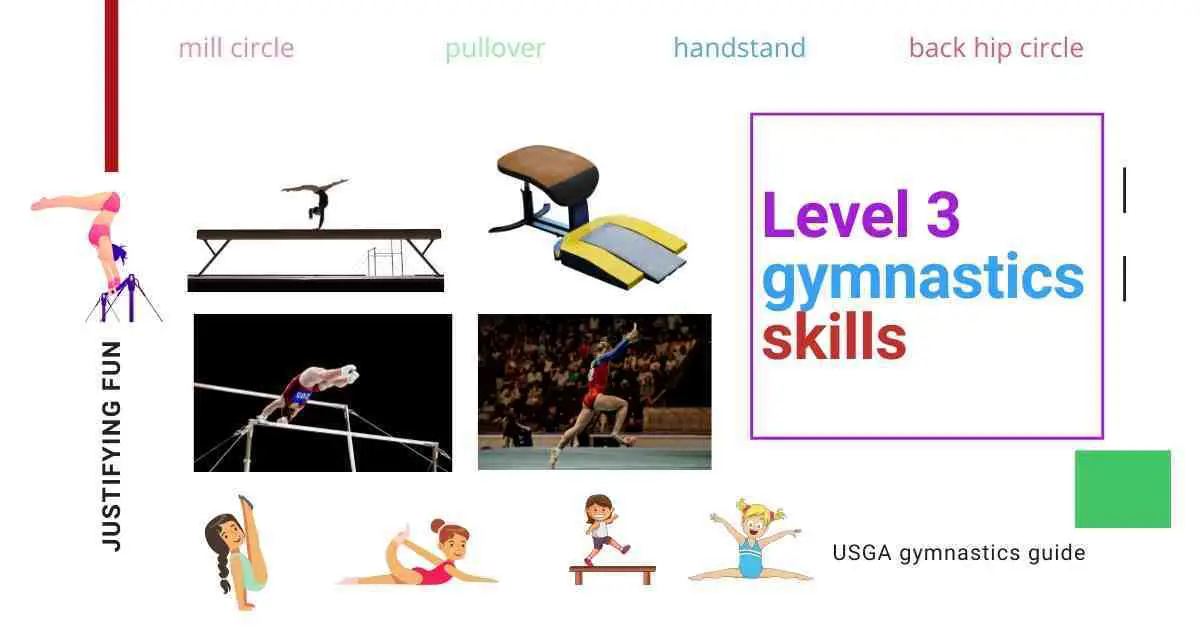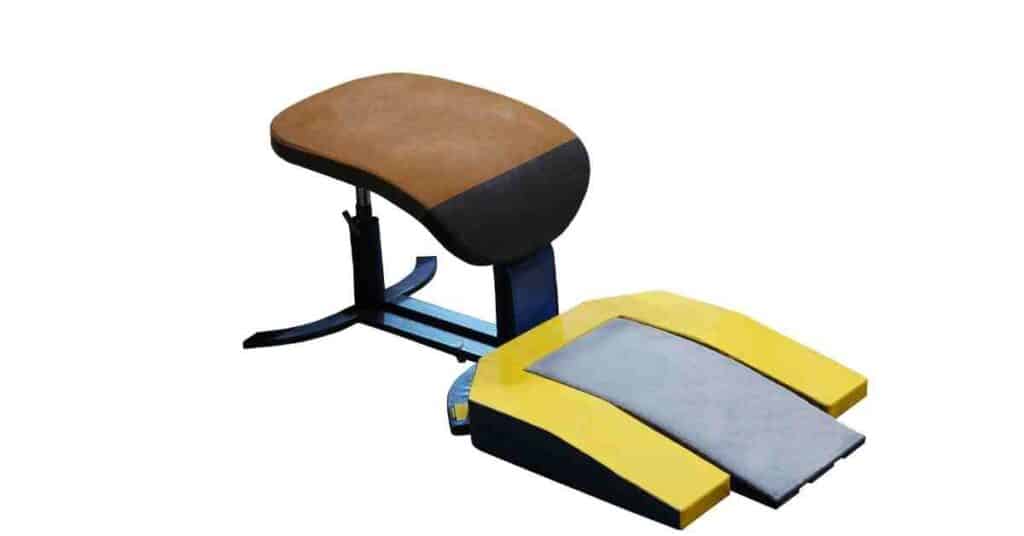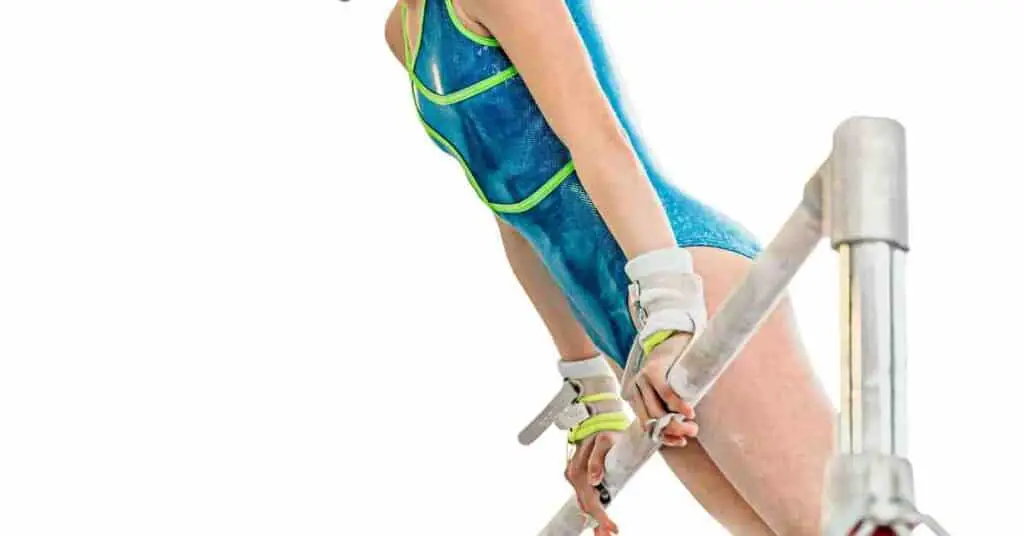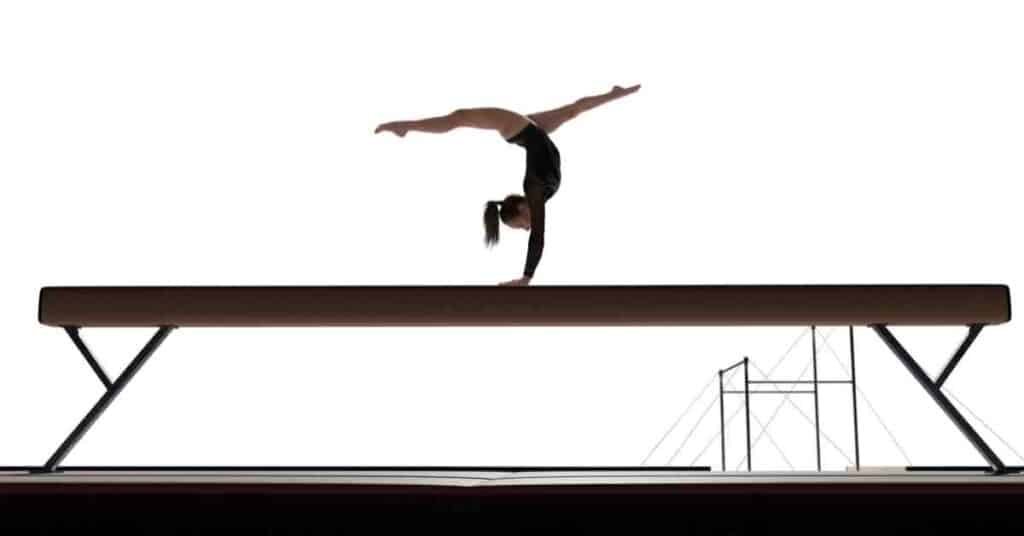
Gymnasts aren’t required to compete and achieve USAG level 3. Level 3 is the last gymnastics level in the Junior Olympic program before the compulsory level 4. Level 3 gymnastics requirements include the challenging round-off back handspring which is a lot of fun to compete with and looks really impressive once you’ve mastered it.
After moving up from level 2 a lot of gymnasts find the level 3 requirement to perform a vertical handstand on beam and side handstand dismount off the beam to be challenging but this depends a lot on the gymnasts preferred gymnastics apparatus.
- Upgrade Gymnastic Balance Beam For Kids Of All Levels: In order to give you one more professional gymnastic beam, our engineer design this balance beam with upgrade patented structure, this new style…
- 1 Beam 2 Modes: This balance beam has two modes, one mode is floor balance beam, height is 9 inch, suitable for beginner, the other is adjustable balance beam, height is from 13 inch to 17inch for…
- Extra Firm Pad Make Balance Beam More Safe: This folding balance beam pad is one hundred percent high density EVA, extra firm to offer stable landing and act as cushioning to reduce impact on joint of…
- Popular Size Suitable For All Age Kids: Beam length is 6ft, length enough for kids to do exercise on it. Up width is 4 inch, the same as competition. Base width is 6 inch, base width is larger than up…
- Adjusts 2 ways: from low mode to high mode, and also incrementally in high mode. Meet the different heights you need.The adjustable balance beam that has both a floor mode for beginners and a high…
- WIDE APPLICATION: 8 FT long with a 4 in balancing surface our junior gymnastics pad is a high quality low beam for girls and boys looking to practice moves such as handspring, cartwheel, handstand,…
What is level 3 in gymnastics?
When you start learning gymnastics you’ll want to learn new skills and try to compete in a gymnastics competition known as a gymnastics meet. To be able to learn more skills and keep track of where you are up to, the USAG created a set of levels so you can see how far you’ve come in gymnastics. Each level is a little more difficult than the level before as you’ll learn skills that are a little bit harder, pushing you to improve your skills. Level 3 is one of the first levels most gymnasts try to achieve in gymnastics and you’ll learn a lot of fun gymnastics skills in level 3.
Level 3 gymnastics skills list
Here is a list of all the skills you’ll learn while working your way through USAG level 3. Click on any highlighted skills to learn more about that skill and see some drills and tips that will help you master it.
- Flat back handstand onto mat stack.
- Single leg squat through.
- pullover.
- front hip circle.
- mill circle.
- underswing dismount.
- back hip circle.
- handstand forward roll.
- split jump.
- handstand to bridge to kickover.
- split leap.
- backward roll into push up position.
- round-off back handspring.
- straight jump.
- handstand.
- side handstand dismount.
Level 3 gymnastics Vault

The level 3 vault is when you’ll progress from the jump to handstand you learnt at level 2 and learn the flat back handstand.
Level 3 Vault skill 1 – Flat Back Handstand onto Mat stack
To avoid deductions at level 3 make sure you hold good tight posture during a good strong vertical handstand with your arms straight while supporting the handstand. Failing to maintain a straight body is a common reason for deductions with the level 3 vault skills.
Level 3 gymnastics Bars

Level 3 gymnastics bars requirements introduce the back hip circle for the first time. the 6 skills included in level 3 bars requirements are more challenging than level 1 and it is a good idea to use skill progressions with your coach to build up the different parts of each gymnastics skill so you can understand each movement and feel the correct form.
In 2018 a perfect 10 was scored 9 times by gymnasts performing a competitive level 3 gymnastics bars routine in 2018
Level 3 Bar Skill 1 – Single Leg Squat Through.
Failure to show a straight line from your feet to your shoulder with a hollow body position will result in you losing 0.20 points during your routine.
Bar Skill 2 – Pullover
For the pullover you have to place your chin above the horizontal bar, squeeze your core and keep your legs and feet together. Look straight ahead and and try not to let your head lean back. Keep your arms bent until your body is above the bar and when your feet begin to come down, you should feel like you are pulling your chest up.
Bar Skill 3 – Front Hip Circle
Make sure you maintain good control when returning to the bar after performing the front hip circle at level 3.
Bar skill 4 – Mill Circle or Basket Swing – Single leg.
The mill circle challenges a lot of level 3 gymnasts. It takes a lot of practice to avoid hooking your leg on the bar. Practice this skill consistently and you’ll never have to have it again after meeting all the level three requirements.
Bar skill 5 – Under swing Dismount.
Keep a nice tight posture with your stomach pulled in tight and shoulders rounded during the underswing dismount. Your head should be straight at all times, don’t tilt it backwards. Failure to extend your body enough during flight & a low height results in deductions of 0.20 at gymnastics level 3.
Bar Skill 6 – Back Hip Circle
You’ve been learning and had to do a back hip circle at level 1 and 2 so you should be confident with this gymnastics skill.
Level 3 Gymnastics Floor
Gymnastics level 3 includes some exciting and challenging floor skills. The round-off back handspring is one of the most difficult level 3 skills gymnasts have to master.
Floor Skill 1 – Handstand Forward Roll
Floor skill 2 – Split Jump ( 90 degree Leg separation )
The split jump is challenging because usually when you jump up and do the splits, it feels more natural to move forwards so it takes time to be able to stay in the same place.
Use a resistance band to increase your leg strength and flexibility to make the level 3 split jump easier to learn. Kicking up with your back leg just before your front leg goes up naturally, can help you to stay in place and not move forwards.
Do lots of stretching with resistance bands as well, they are a great tool for any skill involving the splits. The split jump has a really high skill value in the code of points that the USAG provide, which means it isn’t an easy skill to master. Keep working on it and ask your coach to add striders, uphils and scissones into your level 3 drills.
Floor skill 3 – Handstand – Bridge – Kickover
If you can do a handstand and a bridge kick over then you should be able to transition from the handstand into a bridge and then bridge kickover.
Floor Skill 4 – Split Leap (90 degree split)
To master the split leap and begin to be able to do a 90 degree split leap you need to practice stretching every day and also practice doing the splits and hold them to stretch your thighs. One of your legs is usually better than the other at doing the splits so figure out which leg is most flexible and place this leg in front when doing your level 3 split leap.
Using resistance bands and stretching out your legs into a split position while also stretching and pressing against the bands resistance can help a lot.
Floor skill 5 – Backward Roll into push-up position
If you’ve already mastered the backward roll then you just need to focus on improving your core strength and form so that you can move from a backward roll directly into the push up position with straight arms and shoulder blades squeezed together in the correct form. Planks, candlesticks and practising push ups on your knees and toes are great conditioning exercises to help you master this level 3 floor skill.
Floor skill 6 – Round-off back handspring
Level 3 Gymnastics Beam

Your gymnastics level 3 beam requirements involve learning 4 skills. This is less than the 6 skills you learn at level 2 but the difficult has been turned up a level. The beam handstand, 90 degree split leap and side handstand dismount are all difficult skills, but once you master them and build up the flexibility, balance and leg strength for the split leap, you’ll be fine.
Be patient, there is no rush, just let your body get their in it’s own time, work hard, use the right drills and you’ll pass level 3 beam soon.
Level 3 beam skill 1 – Straight Jump
Beam Skill 2 – Handstand
The handstand is a skill that you need to practice to be able to balance well. Perform a handstand against a wall, with your hands close to the wall and hold it for as long as you can. Doing this a few times every day will help you build up the strength you will need to hold a steady handstand on the beam.
Ask your gymnastics coach to teach you how to practice falling out of a level 3 beam handstand. There are a few techniques you can use to safely fall out of a handstand when you lose balance.
Beam skill 3 – Split Leap ( 90 degree split )
Beam skill 4 – Side Handstand Dismount
Level 2 requires gymnasts to learn the handstand dismount but at level 3 you have to do a side handstand dismount. To be able to master the side handstand dismount gymnasts need to be able to balance well, using their core for stability and the strength to dismount out of the handstand onto the mat.
How old is a level 3 gymnast?
On average the minimum age for a level 3 gymnast is 7-10 years old but some gyms have gymnasts competing at level 3 who are younger and older. You can start working towards your level 3 gymnastics skills at 6 years old. You don’t need to have completed level 1 and level 2 to be able to compete and master level 3 skills. It is a good idea to have learnt gymnastics level 1 and 2 skills though, or attended a recreational gymnastics class before trying level 3 skills so that you have some experience which will make it easier for you to master skills at this level.
Moving up from level 3
If you have mastered all the gymnastics requirements at level 3 well done! You are now able to move on to level 4 which is the first compulsory gymnastics level in the USAG Junior Olympic program. We hope you have enjoyed your gymnastics journey so far. For additional tips and advice at this level check out our recommended gymnastics coaching books.



